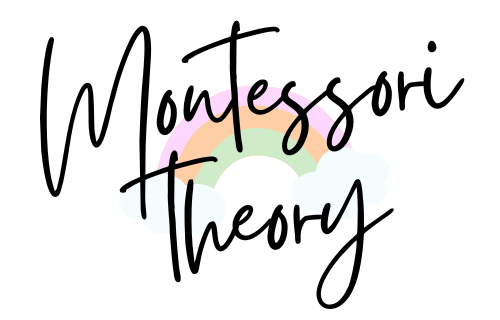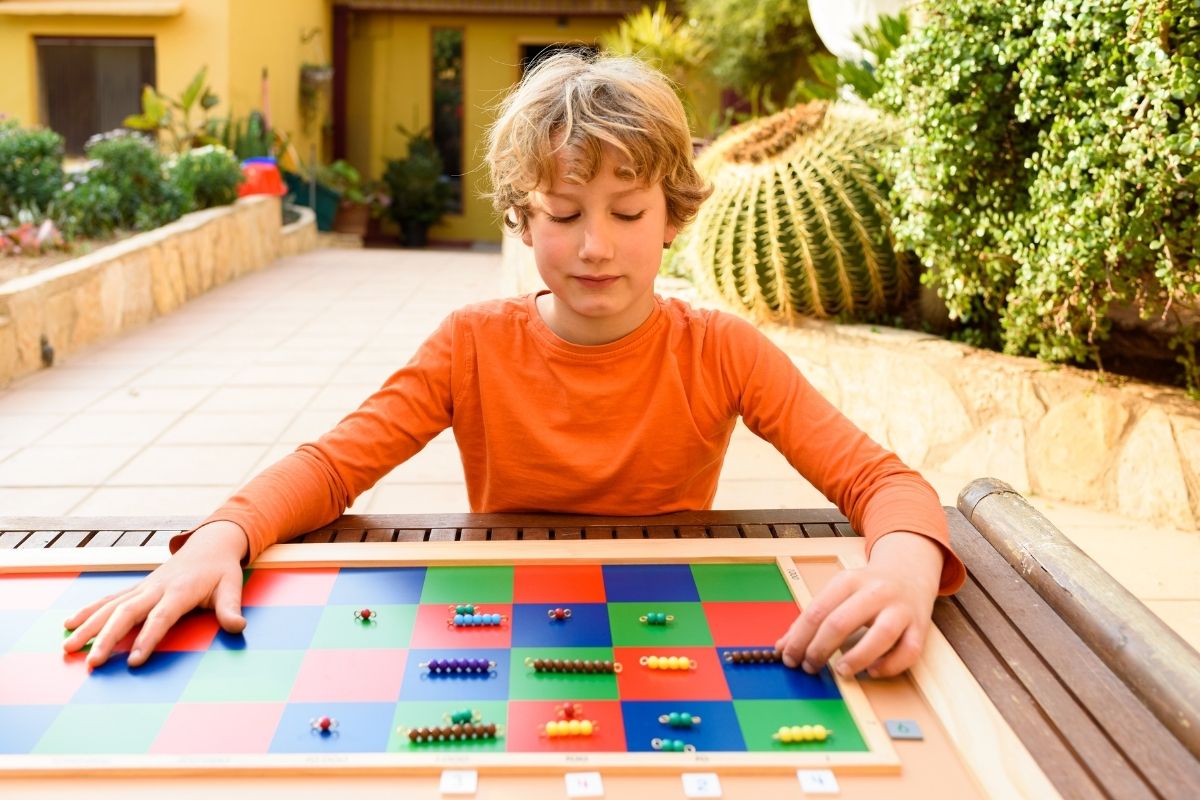As parents and educators, we are constantly on the lookout for innovative ways to make learning engaging and enjoyable. The Montessori checkerboard, like many Montessori materials, has its roots in Dr. Montessori’s observations. Recognizing the need for a tangible way to teach multiplication, especially large multiplications, the checkerboard was born. Over the years, it has evolved, with educators making slight modifications to improve its effectiveness and adaptability.
What is a Montessori Checkerboard
Primarily used for long multiplication exercises, the Montessori checkerboard is a colorful, tactile math material designed to enable children to grasp complex mathematical concepts with ease. Typically, children between the ages of 6 to 9 are introduced to this tool. It consists of a grid with alternating colors representing different place values from units to millions. In addition, there are numeral or bead bars that represent one to nine beads in corresponding colors.
A key principle within the Montessori method is teaching abstract ideas through concrete materials. The checkerboard allows students to visualize the multiplication process and manipulate physical representations of numbers, fostering a deeper understanding of mathematical concepts. Prior to using the checkerboard, it is essential for children to be acquainted with basic multiplication facts and have practiced simple multiplication exercises. Once familiar and comfortable with these foundational skills, they will effortlessly transition to utilizing the checkerboard for more demanding equations.
Checkerboard Components & Features
At first glance, the checkerboard might seem like a simple grid of colored squares. But each color, each square has a purpose. The checkerboard is typically a large board with alternating colored squares, much like a chessboard. The colors—usually red, blue, and green—represent units, tens, hundreds, and so on. Some checkerboards, made from materials like felt or cotton, can be rolled up, making them perfect for homeschooling or classroom settings.
- Layout: The checkerboard is a large, flat board that features a checkered pattern. The squares are alternately colored, typically with a combination of green, blue, and red squares, much like a chessboard.
- Size: The board is sizable enough to accommodate multiple bead bars for multiplication exercises, usually consisting of several rows and columns.
- Colors: The squares are usually colored red, blue, and green. Each color represents a specific place value—units, tens, hundreds, and so on.
- Number Tiles: Accompanying the board are number tiles or beads that represent numbers from 0 to 9. These are used to lay out the numbers being multiplied.
- Multiplication Beads: The checkerboard is paired with colored bead bars, numeral cards, and occasionally other Montessori tools. These bead bars, typically arranged in strings or tubes, symbolize the outcomes of multiplication tasks.
Montessori Checkerboard Purpose & Benefits
The primary purpose of the Montessori checkerboard is to provide a hands-on, tactile method for children to learn and understand multiplication. It allows children to visualize the multiplication process, especially for large numbers, making the abstract concept of multiplication more concrete and tangible.
As children engage with this dynamic math tool, they inevitably reap numerous benefits:
-
Visual Representation of Multiplication
The Checkerboard provides a tangible way for children to visualize the multiplication process. By placing bead bars on the board, abstract numerical concepts become concrete, allowing students to see the progression of multiplication step by step. As they become familiar with the board, they can gradually perform multiplication mentally, relying less on the visual aid.
-
A Concrete Understanding of Abstract Concepts
The use of physical materials to break down complex multiplication problems helps instill a deep-rooted grasp of abstract mathematical principles. The checkerboard fosters essential problem-solving skills and clarifies nuanced concepts such as carrying over and place value alignment.
-
Increased Confidence in Math Abilities
By mastering large number multiplications on the Montessori checkerboard, students significantly boost their self-esteem and confidence regarding their mathematical capabilities. This enhanced belief in their abilities paves the way for achieving success in advanced mathematical endeavors that may be encountered later on.
-
Inclusivity and Catering to Diverse Learner Needs
The tactile nature of this hands-on learning experience accommodates various learning styles and preferences. It is particularly beneficial for those who may find it difficult to comprehend mathematics through traditional paperwork methods, allowing more inclusiveness within the burgeoning educational landscape.
How to Introduce the Checkerboard to Children
Introducing the Montessori checkerboard begins with setting the foundation. Before diving into large multiplications, children are first familiarized with the concept of place value. They start with the unit row, understanding the value of each colored square. As they progress, they move to tens, hundreds, and so on. The beauty of the checkerboard is its adaptability. Whether a child is just starting with multiplication or is already familiar, the checkerboard offers challenges and learning at every level.
How to Use Montessori Checkerboard For Multiplication Exercises
1. Choosing a Problem
Begin by selecting a multiplication problem involving two multi-digit numbers. For instance, if you’re multiplying ‘254 by 32’, the number 32 (multiplier) will be represented horizontally along the top row, while 254 (multiplicand) will be vertically positioned on the right-hand side of the board.
2. Setting Up the Multiplier
The multiplier is represented using bead bars that are placed horizontally on the top row of the Checkerboard. Each bead bar’s color corresponds to a specific number, aiding in easy identification.
3. Laying Out the Multiplicand
The multiplicand is represented using bead bars, which are set vertically on the rightmost columns of the Checkerboard. The placement follows a descending order, with the highest place value at the top and the lowest at the bottom.
4. Positioning Numeral or Bead Bars
Place the corresponding numeral or bead bars on the respective rows and columns based on the chosen numbers. Each color represents a specific place value. For example, with the number 254, bead bars with two beads for thousands, five for hundreds, and four for tens are used. For the number 32, three-beaded bars represent tens, and two-beaded bars represent units.
5. Initiating the Multiplication Process
Starting from the rightmost column, multiply the vertical multiplicand bead by the topmost horizontal multiplier bead. This process is repeated for each bead in the multiplicand column, moving from right to left.
6. Recording Results
As multiplication progresses, place the resulting bead bars on the Checkerboard. This visual representation offers a clear view of the multiplication product. Ensure beads are placed in the appropriate squares, aligned with the correct place values.
7. Summation
After completing the multiplications for each column, it’s time to sum up. Starting from the rightmost column and moving left, add up the bead bars in each column. If there’s a need to carry over (like when the sum exceeds 10 in a column), transfer the excess to the next left column. The final result on the Checkerboard provides a tangible understanding of the multiplication process, making it easier for the child to grasp the concept.
Integrating the Montessori Checkerboard into Broader Educational Practices
Gaining proficiency in the use of the Montessori checkerboard not only caters to numerical fluency but also embodies the larger essence of Montessori education. This tool seamlessly merges with broader pedagogical practices by encouraging independent thinking, critical analysis, active engagement, and collaboration amongst learners.
Integrating this colorful Montessori math material into classrooms and homes alike, we can champion the Montessori philosophy, in cultivating an eagerness for learning, community-based work ethics, and a well-rounded understanding of challenging mathematical concepts.




